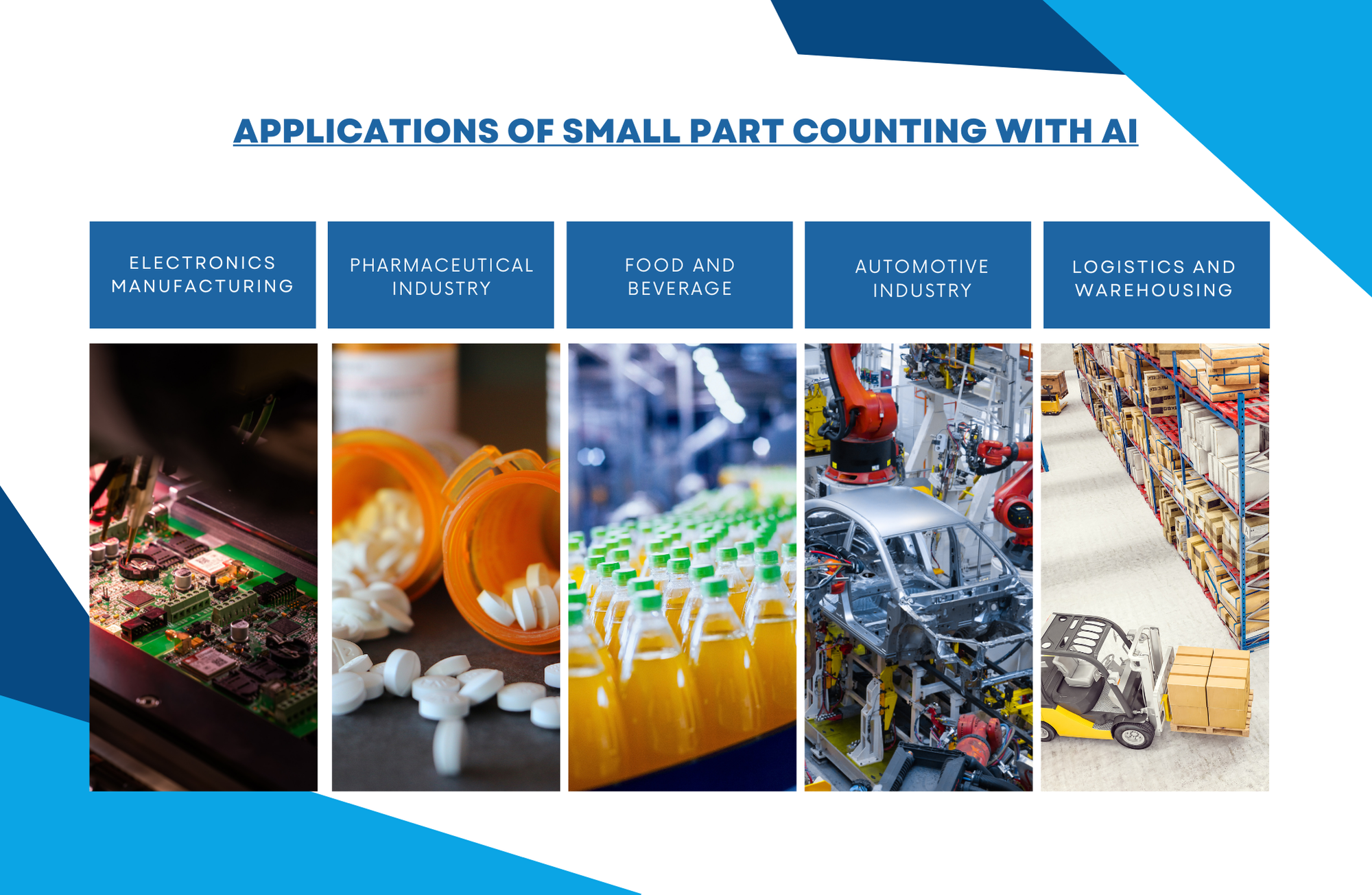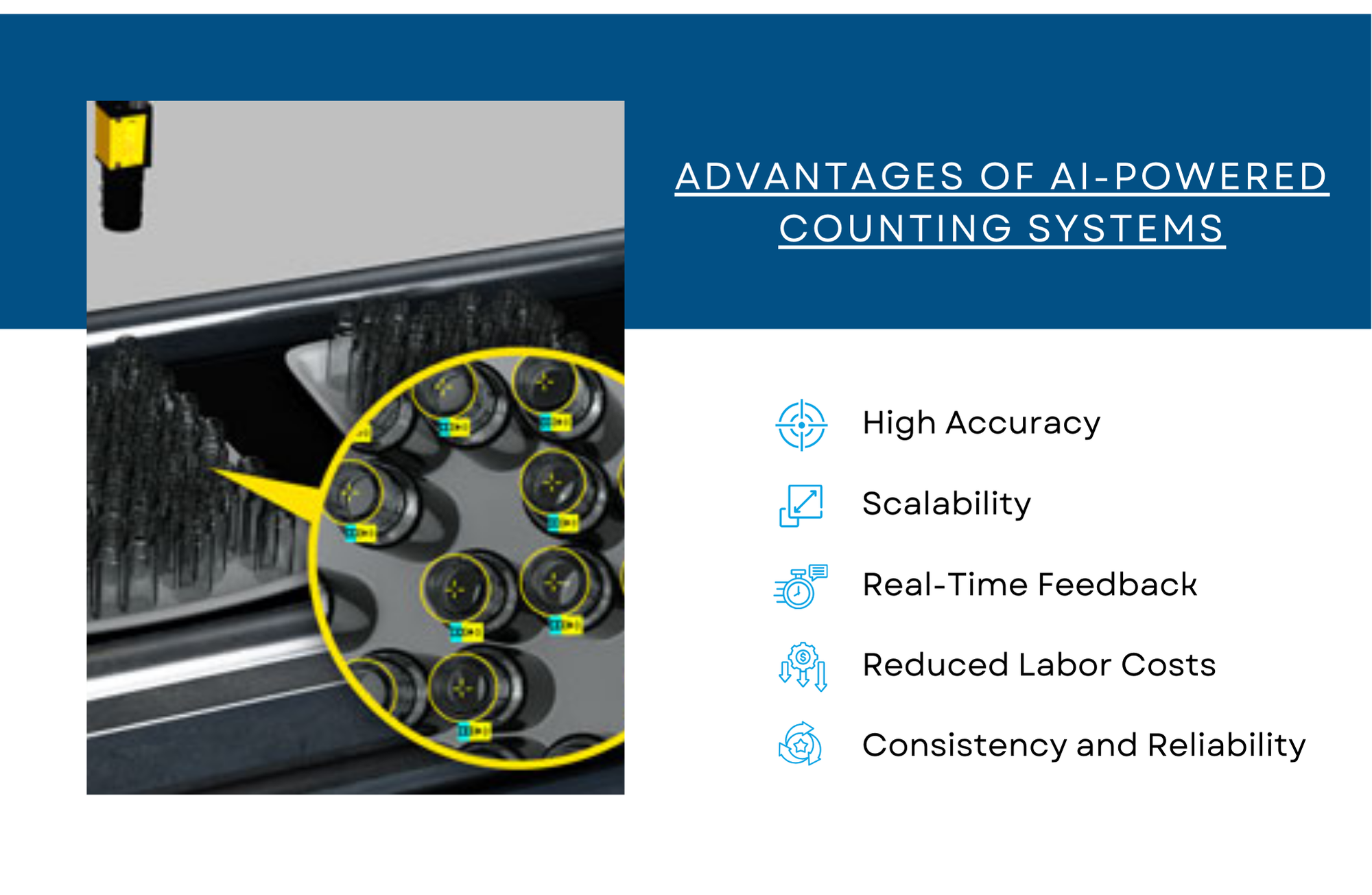Small Part and Components Counting in a Moving Conveyor with AI
Published on: Dec 30, 2024

Written by: Content team, Intelgic
Small Part and Component Counting in a Moving Conveyor Using AI
In modern manufacturing, accurately counting small parts and components as they move along a conveyor is a critical task. Industries such as electronics, pharmaceuticals, automotive, and packaging rely on precise counting for inventory management, packaging, and quality control. Counting small parts manually is not only time-consuming but also prone to errors, especially in high-speed production environments.
AI-powered machine vision systems offer a reliable, efficient, and scalable solution for counting small parts and components on moving conveyors. This article explores the challenges, technologies, and best practices involved in automating the counting process using AI.

Challenges in Counting Small Parts on Moving Conveyors
- High Conveyor Speeds:
- Parts moving at high speeds require systems capable of real-time image processing and analysis.
- Overlapping Components:
- Overlapping or touching parts can make it difficult to distinguish individual components.
- Small and Varied Sizes:
- Tiny components of different shapes and sizes need adaptable detection and counting algorithms.
- Reflective Surfaces:
- Shiny or glossy components can create glare, interfering with image clarity.
- Environmental Factors:
- Dust, vibrations, and varying lighting conditions can impact system accuracy.
Technologies for Counting Small Parts on a Conveyor
1. Machine Vision Cameras
High-resolution cameras capture detailed images of parts on the conveyor belt.
- Line-Scan Cameras:
- Ideal for high-speed lines, capturing images line by line and stitching them together for continuous monitoring.
- Area-Scan Cameras:
- Useful for lower-speed conveyors or where snapshots of specific sections are needed.
2. AI-Powered Image Analysis Software
AI algorithms analyze images captured by cameras to detect and count individual components.
- Object Detection Models:
- Identify and classify individual parts, even when overlapping or partially obscured.
- Segmentation Algorithms:
- Separate overlapping objects, ensuring accurate counting.
- Real-Time Processing:
- Enables instant counting without slowing down the conveyor.
3. Advanced Lighting Systems
Proper lighting ensures clear imaging and accurate detection of components.
- Diffuse Lighting:
- Reduces glare and highlights part edges, improving detection accuracy.
- Backlighting:
- Highlights part outlines for better differentiation between components.
- Multi-Angle Illumination:
- Ensures uniform lighting across the conveyor, minimizing shadows.
4. Synchronization with Conveyor Motion
- Encoders:
- Track conveyor speed and position, ensuring synchronized imaging and analysis.
- Triggers and Sensors:
- Detect part entry and exit points to activate cameras and counting algorithms.
5. Data Analytics and Reporting
- Real-Time Dashboards:
- Display live counts and production metrics.
- Defect Filtering:
- Identifies and excludes defective or out-of-spec parts from the count.
- Batch Tracking:
- Links counts to specific production batches for traceability.
How AI-Powered Counting Works
- Image Capture:
Cameras capture high-resolution images of parts on the moving conveyor. - Pre-Processing:
AI algorithms enhance image quality, removing noise and adjusting for lighting variations. - Object Detection and Segmentation:
- AI identifies individual components, even in overlapping or clustered arrangements.
- Real-Time Counting:
- Detected objects are counted instantly, with counts displayed in real-time on a dashboard.
- Feedback and Alerts:
- Alerts are triggered for discrepancies, such as missing parts or excessive overlaps.
Applications of Small Part Counting with AI
1. Electronics Manufacturing
- Counting components like resistors, capacitors, and connectors on assembly lines.
2. Pharmaceutical Industry
- Verifying the number of pills or capsules in blister packs or bottles.
3. Food and Beverage
- Counting small items like candies, nuts, or snacks for packaging and portioning.
4. Automotive Industry
- Verifying counts of small parts like bolts, washers, and clips in assembly kits.
5. Logistics and Warehousing
- Counting items for order fulfillment and inventory management.

Advantages of AI-Powered Counting Systems
- High Accuracy:
- Detects and counts parts with precision, even at high conveyor speeds.
- Scalability:
- Handles various part sizes, shapes, and production speeds with ease.
- Real-Time Feedback:
- Provides instant counts and alerts, improving operational efficiency.
- Reduced Labor Costs:
- Eliminates manual counting, freeing workers for higher-value tasks.
- Consistency and Reliability:
- Delivers consistent results across shifts and operators.

Best Practices for Implementing AI-Powered Counting Systems
- Choose the Right Camera:
- Select cameras with sufficient resolution and frame rates for your conveyor speed.
- Optimize Lighting:
- Use diffuse or backlighting to enhance part visibility and reduce reflections.
- Calibrate AI Models:
- Train AI algorithms with diverse datasets to handle variations in part size, shape, and arrangement.
- Integrate Sensors:
- Use sensors to synchronize imaging and ensure parts are counted only within the desired area.
- Monitor and Maintain:
- Regularly clean cameras and lighting equipment, and update AI models as needed.
Intelgic’s Expertise in Small Part Counting with AI
At Intelgic, we specialize in designing and deploying AI-powered machine vision systems for counting small parts and components on moving conveyors. Our solutions combine advanced imaging technologies, custom AI algorithms, and real-time analytics to deliver precise, scalable, and efficient counting systems.
Why Choose Intelgic?
- Customizable Solutions:
- Systems tailored to your production line’s speed, part size, and layout.
- Cutting-Edge AI:
- Advanced algorithms trained to handle complex part arrangements and overlapping.
- Seamless Integration:
- Easily integrates with existing conveyor systems and production workflows.
- Actionable Insights:
- Real-time dashboards and reports for better decision-making and process optimization.
Counting small parts and components on a moving conveyor is a challenging but essential task in many industries. AI-powered machine vision systems offer a robust solution, providing accurate, real-time counting even in high-speed and complex production environments. By leveraging advanced imaging, lighting, and AI algorithms, manufacturers can enhance efficiency, reduce costs, and maintain quality standards.
Intelgic’s expertise in AI-powered counting solutions ensures reliable and scalable systems for your production needs. Contact Intelgic today to learn how our cutting-edge technologies can revolutionize your counting processes.

